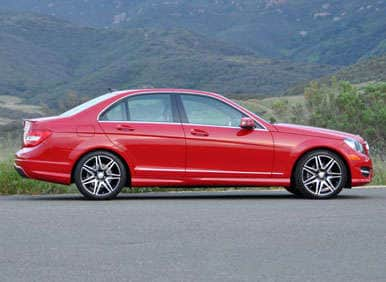Recent Articles
Popular Makes
Body Types
2013 Mercedes-Benz C-Class Road Test and Review
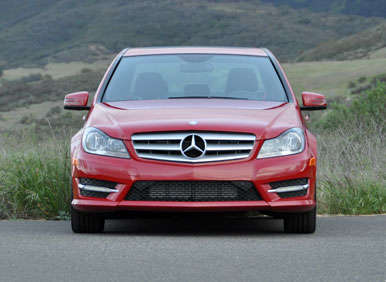
For most luxury brands, the best-selling model is also the least expensive model. That’s because many car buyers aspire to own a luxury car, and as soon as they can swing the monthly payment on an Audi A4, a BMW 3 Series, a Cadillac ATS, an Infiniti G, a Lexus IS, or this, the Mercedes-Benz C-Class, they jettison the decade-old Accord and accept the keys to a luxury-branded car.
I qualify my description as “luxury-branded” because the base versions of these models, the ones touted as lease specials, the ones that grab aspirational buyers with low payments, because they aren’t really luxury cars in the way luxury cars are traditionally defined. Yes, they have more stuff. Yes, they have better engineering. Yes, they have luxury badges. But they’re not a luxury car anymore than a loaded Ford Fusion Titanium with all the option boxes checked is a luxury car.
That’s true in the traditional sense, anyway. Take the badges off of any of these entry-luxury cars and line them up with an unbadged Fusion, and my bet is most car buyers would call the Fusion the luxury car. Especially with that Aston Martin grille, which brings me full circle to this, the 2013 Mercedes-Benz C-Class and its giant three-pointed star embedded in its grille like a thick gold medallion resting in a nest of chest hair.
Given that this emblem has for decades reflected the pinnacle of success and wealth rendered in metal, glass, rubber, and oil, you’d think the C-Class would be the best-selling luxury car in America. It’s not. Last year, BMW brokered deals on nearly 100,000 3 Series models, and Lexus peddled more than 95,000 RX SUVs. By comparison, Mercedes moved nearly 82,000 C-Class models, making it the third best-selling luxury car in 2012, and the 63rd best-selling car in the country.
So much for exclusivity.
Though the current version of the C-Class is nearing the end of its lifespan, we figured it would be a good idea to see if there’s a compelling reason to buy one, aside from the fact that it’s a Mercedes.
2013 Mercedes-Benz C-Class Road Test and Review: Models and Prices
The 2013 Mercedes-Benz C-Class lineup is comprised of 2-door coupes and 4-door sedans equipped with a 4-cylinder or 6-cylinder engine, rear-wheel or 4-wheel drive, and Sport or Luxury equipment series. Prices range from $36,255 for a C250 Sport Sedan with no options to $58,440 for a C350 Sport Coupe with every factory option. Both body styles are also available in high-performance C63 AMG format, which starts at $62,405 for the sedan and tops out at $88,780 for a coupe with every option. All prices include a $905 destination charge, and the C63 AMG prices include a $1,700 gas-guzzler tax.
We elected to test drive the most popular version of the C-Class, the lease special, the C250 Sport Sedan that offers the most accessible monthly payment. Options for our test vehicle included the Dynamic Sport Package ($2,300 – Sport seats with manufactured suede inserts and leatherette bolsters, red seat belts, red contrast cabin stitching, black floor mats with red contrast piping, a sport steering wheel with paddle shifters, speed sensitive steering, an Advanced Agility suspension, an AMG rear spoiler, 18-inch AMG aluminum wheels) and the Premium 1 Package ($2,500 – premium Harmon/Kardon surround sound audio system with an MP3 player and satellite radio, a 10-way power driver’s seat with 4-way power lumbar support and memory seat settings, a power tilt/telescopic steering wheel, heated front seats, and a split-folding rear seat). The final price tag for the Mars Red C250 seen here was $41,055.
If you’re wondering what that 41 grand didn’t buy, here are some examples of equipment missing from my C250 Sport: metallic paint, leather, a navigation system, a reversing camera, keyless passive entry with push-button ignition, parking sensors, Blind Spot Assist, and Lane Keeping Assist. Add these features, and a C250 Sport climbs to $46,875.
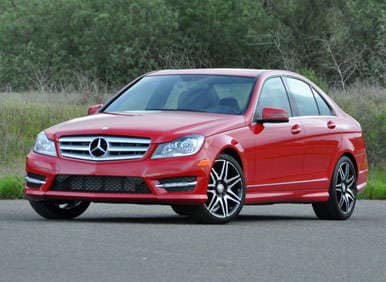
2013 Mercedes-Benz C-Class Road Test and Review: Design
- No changes for 2013
Conservatively styled with a liberal helping of traditional Mercedes-Benz design cues, the 2013 C-Class Sedan is blandly attractive. The Sport models are equipped with a giant three-pointed star emblem embedded in a louvered grille, while the Luxury models have a traditional Mercedes visage complete with stand-up hood ornament. If you want Mars Red paint, seen in the photo, or a variety of staggered-width wheel choices, like the upgraded 18-inch rims shown here, you need to choose the C250 Sport, which also comes with a more aggressive looking front bumper, a mesh lower grille insert, a body kit, a sport suspension, and upgraded braking components.
The C250 Sport’s interior is differentiated from the more traditional C250 Luxury by a 3-spoke sport steering wheel, aluminum rather than wood trim, gray gauge faces, and metal pedals. Most interior colors for the Sport model have a black upper dashboard, door panels, and headliner. My test vehicle was black inside, with aluminum trim, and had the Dynamic Sport Package which adds sport seats with manufactured suede inserts, leatherette bolsters, a flat-bottomed sport steering wheel with paddle shifters, red-contrast stitching, red piping on the floor mats, and red seat belts. I liked everything about this cabin’s technical décor, except the red seatbelts, which are ridiculous. My wife, however, thought they were swell.
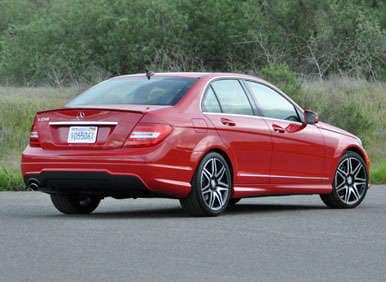
2013 Mercedes-Benz C-Class Road Test and Review: Comfort and Cargo
- No changes for 2013
The Mercedes C-Class Sedan is a small car. It also sits relatively low to the ground. If you’re small and relatively close to the ground, you’ll find plenty of comfort inside of this vehicle. If you’re like me, and you’re not small or close to the ground, a C-Class is snug. Let’s call it a tailored fit.
To find the right mix of thigh support and backrest angle, combined with a proper marriage of my arms to the C250 Sport’s excellent steering wheel, the bottom cushion was positioned too low and too far back in the car to make entering and exiting the vehicle anywhere close to graceful. Once situated in the driver’s seat, I found it to be rather hard and unyielding, but with time, I discovered that it provides terrific support and comfort over time.
Though it looks uncomfortable, the C250’s back seat isn’t. Four people of six-foot stature can ride in this car, as long as the people in the front seats don’t like to drive or ride with the seat half reclined. The rear bench sits high off the floor, and the front seatbacks are scalloped to provide additional space for knees and legs. The problem is getting big feet tucked into the car. My size-12s required careful insertion and extraction.
Given the meager 12.4 cu.-ft. of trunk space, luggage also requires careful insertion and extraction. Nevertheless, the car swallowed my family and goodies following a light big-box store run, thanks in part to the cargo area’s useful shape and partially enclosed trunk lid hinges.
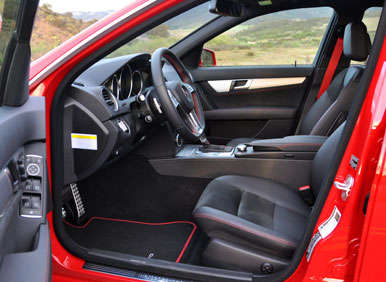
2013 Mercedes-Benz C-Class Road Test and Review: Features and Controls
- Standard mBrace2 telematics system with 6 free months of service
With giant touchscreen control panels becoming commonplace in all price classes, the C-Class models have a simultaneously quaint yet refreshing approach. Buttons, knobs, and stalks control almost everything, the silver controller sitting on the center console of my sparsely equipped test vehicle serving only to access stereo-related menu items on the black, white, and shades of gray radio display screen.
Not only is the C-Class almost retro by modern standards, the controls are also relatively simplistic and logical in both their location and operation, though buttons rendered in silver plastic are hard to discern during the day. If there’s a substantial complaint with regard to the C250 Sport’s controls, it relates to how most of them creak under fingertip pressure, making the car feel cheap and the window sticker too expensive.
Another hit to the car’s value equation rests with the lack of equipment on my test car. I’d love to discuss how easy the navigation system is to use, how well the reversing camera works, and how useful or irritating the Blind Spot Assist and Lane Keeping Assist systems are, but I can’t.
What I can tell you is that the standard mBrace2 technology that’s been added to the 2013 C-Class can be used to access the Internet and social media, take advantage of concierge services, find your car in a crowded parking lot, perform remote diagnostic checks, send an alert if a valet takes the car for a longer ride than is necessary, and more.
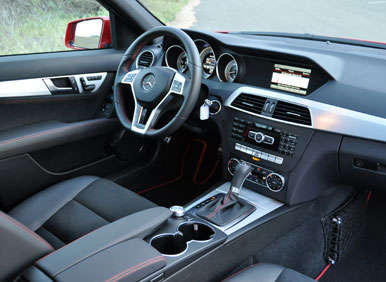
2013 Mercedes-Benz C-Class Road Test and Review: Safety and Ratings
- Standard mBrace2 telematics system with 6 free months of service
In addition to conveniences, the 2013 C-Class models’ standard mBrace system provides valuable safety features. For example, the SOS button inside the car puts occupants in instant contact with a live operator who can help in times of assistance, and if the airbags deploy or the seatbelt retractors tighten, the operator reaches out to the car to make sure everyone is OK, and to help get police, fire, or medical rescuers on the scene as soon as possible. The mBrace system is also useful in households with young drivers. It can be programmed to notify parents if a pre-set speed is exceeded or if a geographic boundary is crossed.
Another standard safety feature for the 2013 C-Class is called Attention Assist, which is designed to alert a driver if it detects drowsiness. According to Mercedes, the system monitors 70 different parameters related to driving patterns in the first minutes of a trip, and then provides audible and visual alerts if the driver’s behavior strays from those measured characteristics.
Safety options include a reversing camera, side-impact airbags for the rear seat, parking sensors, bi-Xenon headlights with Active Curve Illumination, Adaptive Highbeam Assist, a Blind Spot Assist system, a Lane Keeping Assist system, and a Driver Assistance Package equipped with active versions of the Blind Spot and Lane Keeping Assist systems plus an adaptive cruise control system with Pre-Safe and Pre-Safe Brake systems.
The C-Class Sedan receives a 5-star overall crash-test rating from the National Highway Traffic Safety Administration. It doesn’t get better than that. The Insurance Institute for Highway Safety (IIHS) names the C-Class Sedan a “Top Safety Pick” for 2013.
There is a caveat, however. In the new small overlap frontal impact test conducted by the IIHS, which is designed to measure protection levels if a car collides with a tree, a pole, or an oncoming vehicle on the front left corner, the C-Class received a “Poor” rating. Several competing models did much better than that, such as the Acura TL, Lincoln MKZ, and Volvo S60.
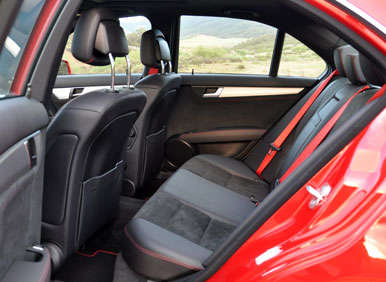
2013 Mercedes-Benz C-Class Road Test and Review: Engines and Fuel Economy
- C300 4Matic models get new 3.5-liter V-6 engine
- C300 4Matic and C350 models get automatic stop/start technology
- Optional Sport Plus Package with 18-inch wheels, performance suspension, performance exhaust, performance brakes, performance transmission calibration with downshift rev matching
Mercedes installs a turbocharged 1.8-liter 4-cylinder engine in the C250 Sedan, one that makes 201 horsepower and 229 lb.-ft. of torque. Compared to the 3.5-liter V-6 engine in the C300 4Matic (248 hp./251 lb.-ft.) and the C350 (302 hp./273 lb.-ft.), that doesn’t seem very impressive. Let me tell you something: unless you need 4Matic for snowy winters, the C250 will prove plenty powerful.
That’s because it makes its peak torque between 2,000 rpm and 4,300 rpm, in advance of peak horsepower’s arrival at 5,500 rpm. The result is strong, linear power delivery after suffering an initial – and short – bout of turbo lag, producing acceleration to 60 mph in 7.1 seconds by the Mercedes-Benz stopwatch.
Still unimpressed? Take a C250 for a test drive, before trying the C350 model. You might find it more difficult to justify the $6,000 premium for the latter model.
The C250 Sedan is equipped with a 7-speed automatic transmission, which delivers power to the car’s rear wheels. My test car had the optional Dynamic Sport Package, which included a flat-bottomed steering wheel with paddle shifters. Press the “M” button on the center console, or use one of the paddles, and the C250 turns responsibility for choosing gears over to the driver.
According to the EPA, the C250 is expected to return 22 mpg in the city, 31 mpg on the highway, and 25 mpg in combined driving. I split my time 50/50, and averaged 23.3 mpg. But I must admit, I took full advantage of the Benz’s turbocharged whooshiness on a regular basis.
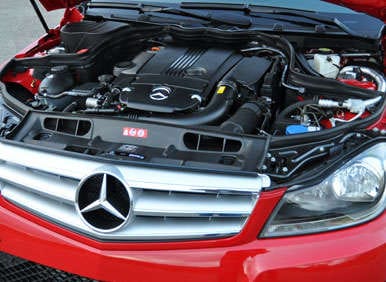
2013 Mercedes-Benz C-Class Road Test and Review: Driving Impressions
I realize that the horsepower and torque figures for the C250’s engine don’t look impressive on paper, but trust me when I tell you that the car feels much stronger than the numbers suggest, in the same way that a turbocharged Audi or Volkswagen engine thrills with low values. Granted, the Mercedes motor isn’t quite as generous as the Audi/VW 2.0-liter 4-cylinder in terms of power and torque, and neither is as accessible from certain parts of the engine’s operating range, but the C250’s little engine is impressive.
The 7-speed transmission is calibrated to upshift as soon as is practical, depending on how the driver is driving the car, in order to conserve fuel. Use the manual mode or the paddle shifters, and you can decide for yourself when it’s appropriate to shift. Trouble is, the powertrain is so refined and/or isolated from the cabin, that it’s hard to discern the audible clues that indicate when its time to make a gear change.
The C250’s steering is excellent. The sport steering wheel is comfortable to grip, assist levels are always perfect, and the steering is responsive and accurate. I’m a big fan of the optional P255/35ZR18 Continental ContiSportContact performance tires, too, which supply outstanding grip combined with remarkable quiet on all but rougher pavement textures.
What Mercedes calls an Agility Control suspension is standard equipment for the C-Class, equipped with shock absorbers that individually adjust according to road surface and driving style. When hustling the car on a favorite backroad, the suspension proves to be a model of perfection. Around town, I detected too much jounce in the rear end, which frequently felt unsettled depending on pavement irregularities or undulations.
The braking system is fairly sophisticated, equipped with Hill Start Assist, a Hold feature, Automatic Brake Drying, and Predictive Brake Priming, which activates in expectation of a requirement for maximum braking capability if the driver suddenly lifts off the accelerator pedal. That’s great. Unfortunately, the C250’s brake pedal regularly behaved in such a manner as to get my heart racing a bit, delaying response, feeling slightly mushy, and when the C250 was driven really hard, feeling unprepared for the task at hand.
I realize, however, that the majority of the almost 82,000 people buying this car are never, ever, going to drive it like I did on my test loop. Those of you cruising suburbia and commuting into the city need not be concerned. A Mercedes-Benz C250 feels solid, secure, and sporty enough to put an occasional smile on your face. That’s what this car did for me, whether I was cruising around town or exercising the car on some of my favorite mountain roads.

2013 Mercedes-Benz C-Class Road Test and Review: Final Thoughts
The 2013 Mercedes C250 Sport might wear a luxury badge, but it is not plush, or warm, or inviting. Rather, the car takes a cold, purposeful, mechanical approach to providing transportation, espousing a classically Germanic, engineering-focused philosophy about what a good car ought to be. Personally, at this test car’s price point, I’d still be shopping for an Audi A4 or a Cadillac ATS. But the Mercedes would be on the short list, and not at all because of the three-pointed star in its grille.
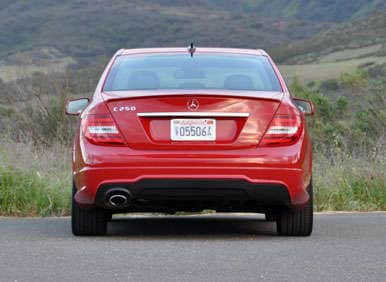
2013 Mercedes-Benz C-Class Road Test and Review: Pros and Cons
- Torquey turbocharged engine
- Seat comfort
- Quality interior materials
- Appealing good looks
- Impressive handling
- 5-star NHTSA crash-test rating
- 23.3 mpg without even trying
- Lousy small overlap frontal-impact IIHS crash-test rating
- High price, minimal equipment
- Low front seating positions
- Cramped rear foot space
- Cheap-sounding switchgear
- Off-the-line turbo lag
Mercedes-Benz supplied the vehicle for this review
2013 Mercedes-Benz C250 Sport photos by Christian Wardlaw
